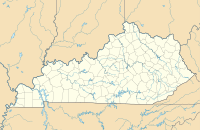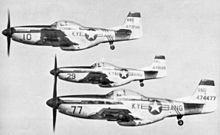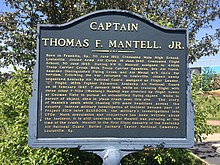Mantell UFO incident
On January 7, 1948, 25-year-old Captain Thomas F. Mantell, a Kentucky Air National Guard pilot, died in the crash of his P-51 Mustang fighter, after being sent in pursuit of an unidentified flying object (UFO). The event was among the most publicized early UFO incidents.
In 1956, Air Force Captain Edward J. Ruppelt (the first head of Project Blue Book) wrote that the Mantell crash was one of three "classic" UFO cases in 1948 that would help to define the UFO phenomenon in the public mind, and would help convince some Air Force intelligence specialists that UFOs were a "real", physical phenomenon.[2] The other two "classic" sightings in 1948 were the Chiles-Whitted UFO encounter and the Gorman dogfight.[3]
Historian David M. Jacobs argues the Mantell case marked a sharp shift in both public and governmental perceptions of UFOs. Previously, the news media often treated UFO reports with a whimsical or glib attitude reserved for “silly season news”. Following Mantell's death, however, Jacobs notes "the fact that a person had died in an encounter with an alleged flying saucer dramatically increased public concern about the phenomenon. Now a dramatic new prospect entered thought about UFOs: they might be not only extraterrestrial but potentially hostile as well."[4]
Incident[ edit]
Mantell was an experienced pilot; his flight history consisted of 2,167 hours in the air, and he had been honored for his part in the Battle of Normandy during World War II.[5]
On 7 January 1948, Godman Army Airfield at Fort Knox, Kentucky, received a report from the Kentucky Highway Patrol of an unusual aerial object near Madisonville, Kentucky. Reports of a westbound circular object, 250–300 feet (80–90 m) in diameter, were received from Owensboro and Irvington.[6]
At about 1:45 p.m., Sergeant Quinton Blackwell saw an object from his position in the control tower at Fort Knox. Two other witnesses in the tower also reported a white object in the distance. Colonel Guy Hix, the base commander, reported an object he described as "very white," and "about one fourth the size of the full moon ... Through binoculars it appeared to have a red border at the bottom ... It remained stationary, seemingly, for one and a half hours." Observers at Clinton County Army Air Field in Ohio described the object "as having the appearance of a flaming red cone trailing a gaseous green mist" and observed the object for around 35 minutes.[7] Another observer at Lockbourne Army Air Field in Ohio noted, "Just before leaving it came to very near the ground, staying down for about ten seconds, then climbed at a very fast rate back to its original altitude, 10,000 feet, leveling off and disappearing into the overcast heading 120 degrees. Its speed was greater than 500 mph (800 km/h) in level flight."[8]
Four F-51D Mustangs of C Flight, 165th Fighter Squadron Kentucky Air National Guard—one piloted by Mantell—were already in the air and told to approach the object. Blackwell was in radio communication with the pilots throughout the event.
One pilot's Mustang was low on fuel, and he quickly returned to base. Ruppelt notes that there was some disagreement amongst the air traffic controllers as to Mantell's words as he communicated with the tower: some sources[9] reported that Mantell had described an object "[which] looks metallic and of tremendous size," but according to Ruppelt, others disputed whether or not Mantell actually said this.[10]
The other two pilots accompanied Mantell in steep pursuit of the object. They later reported they saw an object, but described it as so small and indistinct that they could not identify it. Mantell ignored suggestions that the pilots should level their altitude and try to more clearly see the object.[10]
Only one of Mantell's wingmen , Lt. Albert Clements, had an oxygen mask, and his oxygen was in low supply. Clements and the third pilot, Lt. Hammond, called off their pursuit at 22,500 feet (6,900 m). Mantell continued to climb, however. According to the Air Force, once Mantell passed 25,000 feet (7,600 m) he blacked out from the lack of oxygen (hypoxia), and his plane began spiraling back towards the ground. A witness later reported Mantell's Mustang in a circling descent. His plane crashed on a farm south of Franklin, Kentucky, on the Kentucky–Tennessee state line.[11]
Firemen later pulled Mantell's body from the Mustang's wreckage. His seat belt was shredded, and his wristwatch had stopped at 3:18 p.m., the time of his crash. Meanwhile, by 3:50 p.m. the UFO was no longer visible to observers at Godman Army Airfield.[11]
The Mantell incident was reported by newspapers around the nation, and received significant news media attention. A number of sensational rumors were also circulated about Mantell's crash. According to UFO historian Curtis Peebles, among the rumors were claims that "the flying saucer was a Soviet missile; it was [an alien] spacecraft that shot down [Mantell's fighter] when it got too close; Captain Mantell's body was found riddled with bullets; the body was missing; the plane had completely disintegrated in the air; [and] the wreckage was radioactive."[12] However, no evidence has ever surfaced to substantiate any of these claims, and Air Force investigation specifically refuted some claims, such as the supposedly radioactive wreckage.[12] Captain Ruppelt wrote that "I had always heard a lot of wild speculation about the condition of Mantell's crashed F-51, so I wired for a copy of the accident report. [ It] said that... Mantell's body had not burned, not disintegrated, and was not full of holes; the wreck was not radioactive, nor was it magnetized."[13] Mantell was the first member of the Kentucky Air National Guard to die in flight.[14] According to John Trowbridge, historian of the Kentucky National Guard, "There is a real X-Files twist to this, too. Mantell lived almost his entire life in Louisville, but he was born in a hospital in Franklin, only a few miles from where he was killed."[15]
Venus explanation and rejection[ edit]
The Mantell crash was investigated by Project Sign, the first Air Force research group assigned to investigate UFO reports. One writer noted that "The people on Project Sign worked fast on the Mantell Incident. Contemplating a flood of queries from the press as soon as they heard about the crash, they realized that they had to get a quick answer. Venus had been the target of a chase by an Air Force F-51 several weeks before and there were similarities between this sighting and the Mantell Incident. So... the word 'Venus' went out. Mantell had unfortunately been killed trying to reach the planet Venus."[16] An Air Force major who was interviewed by several reporters following Mantell's crash "flatly stated that it was Venus."[17]
In 1952 USAF Captain Edward Ruppelt, the supervisor of Project Blue Book, Project Sign's successor, was ordered to reinvestigate the Mantell Incident. Ruppelt spoke with Dr. J. Allen Hynek, an astronomer at Ohio State University and scientific consultant to Project Sign and Project Blue Book. Hynek had supplied Project Sign with the Venus explanation in 1948, mainly because Venus had been in the same place in the sky that Mantell's UFO was observed.[18] However, by 1952 Dr. Hynek had concluded that the Venus explanation was incorrect, because "Venus wasn't bright enough to be seen" by Mantell and the other witnesses, and because a considerable haze was present that would have further obscured the planet in the sky.[18] Ruppelt also noted Dr. Hynek's statement that Venus, even if visible, would have been a "pinpoint of light", but that eyewitness "descriptions plainly indicated a large object. None of the descriptions could even vaguely be called a pinpoint of light."[19]
Skyhook balloon explanation[ edit]
Having rejected the Venus explanation, Captain Ruppelt began to research other explanations for the incident. He was particularly interested in a suggestion by Dr. Hynek that Mantell could have misidentified a United States Navy Skyhook[20] weather balloon. In Madisonville, Kentucky "the object was seen through a telescope [and] identified as a balloon by one observer."[21] Additionally, between 4:30 and 4:45 PM an astronomer at Vanderbilt University "watched an object in the sky... viewed through binoculars, he said it was a pear-shaped balloon with cables and a basket attached."[22]
However, others disputed this idea, noting that no particular Skyhook balloon could be conclusively identified as being in the area in question during Mantell's pursuit. Despite this objection, Ruppelt thought the Skyhook explanation was plausible: the balloons were a secret Navy project at the time of Mantell's crash, were made of reflective aluminum, and were about 100 feet (30 m) in diameter, consistent with the description of the UFO as large, metallic, and cone-shaped. Since the Skyhook balloons were secret at the time, neither Mantell nor the other observers in the air control tower would have been able to identify the UFO as a Skyhook. But this was never proved, as Ruppelt wrote:[23]
Inexperience with the P-51[ edit]
Researchers[24] have also noted that while Mantell was an experienced pilot, he was rather new to the F-51, and that this relative inexperience could have been a factor in the crash. This does not, of course, account for the identity of the UFO.
Thomas Mantell biography[ edit]
Thomas Mantell
| |
|---|---|
| Born | 30 June 1922 Franklin, Kentucky, U.S. |
| Died | 7 January 1948 (aged 25) |
| Allegiance | |
| Service/ | |
| Years of service | 1942–1948 |
| Rank | Captain |
| Unit | 440th Troop Carrier Group |
| Battles/wars | World War II (Operation Overlord) |
| Awards | Distinguished Flying Cross Air Medal |
Captain Thomas Francis Mantell Jr. ( 30 June 1922 – 7 January 1948) was a United States Air Force officer and a World War II veteran. Mantell was awarded the Distinguished Flying Cross for courageous action during the Operation Market Garden,[25] and an Air Medal with three Oak leaf clusters for aerial achievement.[14][15]
Career[ edit]
Mantell graduated from Male High School in Louisville. On 16 June 1942, Mantell joined the United States Army Air Corps, finishing Flight School on 30 June 1943.[14] During World War II, he was C-47 Skytrain pilot assigned to the 96th Troop Carrier Squadron, 440th Troop Carrier Group, which air dropped the 101st Airborne Division into Normandy, France on 6 June 1944 and participated in Operation Market Garden.
Mantell, then a lieutenant, was awarded the Distinguished Flying Cross for heroism while flying over Holland on 18 September 1944 during Operation Market Garden. He was the pilot of a cargo plane, named Vulture's Delight, towing a glider, when it came under heavy anti-aircraft fire. All but one of the rudder and elevator controls were disabled, and the aircraft's tail was afire. Mantell's crew chief fought the fire with live ammunition detonating. Rather than release the glider, Lt. Mantell decided to continue with his mission. The glider was released at the correct location, and Mantell returned to base. Upon inspection, his aircraft was so damaged that it appeared to be unable to fly. Mantell was nicknamed "Shiny" by his comrades. This was because of his "constant well-scrubbed look." Mantell was also described as "able to think fast and act quickly." [26]
After the war, Mantell returned to Louisville, joining the newly formed Kentucky Air National Guard on 16 February 1947. He became a F-51D Mustang pilot in the 165th Fighter Squadron.
Following his death in January 1948, Mantell's remains were sent to Louisville for burial in the Zachary Taylor National Cemetery.[citation needed]
On 29 September 2001, the Simpson County Historical Society unveiled a historical marker in honor of Thomas Mantell in his hometown of Franklin. The marker is located at the exit off Interstate 65.





Nenhum comentário:
Postar um comentário